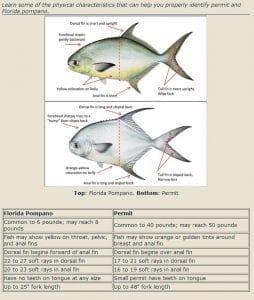Identifying Permit VS Pompano
 Can you tell the difference?
Can you tell the difference?
These fast-swimming coastal fishes are a challenge to catch and, as a result, are coveted by
Florida anglers; the pompano has the added enticement of being a popular dinner entree. The two species are remarkably similar in appearance but very different in size as adults—a situation that confuses many anglers who, thinking they have reeled in a world-record-size pompano, are disappointed to learn that they have actually hooked a permit, and a small one at that.
Pompano and permit are members of the jack family, Carangidae, which includes about 140 species worldwide. Jacks are characterized by their silvery, thin bodies and deeply forked tail fins. Many have elongated dorsal fins. Florida relatives of the pompano and permit include palometa, crevalle jack, yellow jack, lookdown, amberjack, and a variety of scads.
Because pompano and permit are very similar in appearance, anglers often confuse them. Adult pompano and permit can be distinguished from each other by their size. Pompano rarely grow larger than seven pounds, whereas permit weighing 40 pounds are common. The body of a juvenile permit is deeper than that of a pompano of similar length; also, the anal fin of the juvenile permit is orange. As permit grow, their body depth decreases in relation to their length, and fin coloration changes from orange to yellow, making them look like huge pompano. The best way to distinguish between these species is to count the dorsal and anal fin rays. Pompano have more.
Florida pompano (Trachinotus carolinus) have a deep, thin, silvery body with a greenish gray back, which slopes gradually to a rounded head with a blunt snout and small mouth. In dark waters, pompano may have a gold tinge on the throat, belly, and fins. Six short spines are located in front of an elongated dorsal fin, which is set low on the fish’s back and is matched by a slightly shorter anal fin underneath. The first few soft rays of these fins are elongated, followed by a narrow band of soft rays that lead to the deeply forked Vshaped tail. The dorsal fin has 22 to 27 soft rays; the anal fin has 20 to 23 rays. The fins of pompano may be yellow. Florida pompano may reach 25 inches and 8 pounds.
The body of the permit (Trachinotus falcatus) is silvery, with a dark or iridescent blue back. In dark waters, orange or even golden tints on larger specimens may be visible around the breast. The dorsal fin of the permit has 17 to 21 rays; the anal fin has 16 to 19 rays.
Many adult permit have a large circular black splotch on their sides, behind the base of the pectoral fin.
Young permit have bright orange pelvic and anal fins, as well as small teeth on the tongue. Permit may grow to 59 inches and 79 pounds.
Both pompano and permit have distinctive plates at the back of the mouth that help them crush the hard-shelled crustaceans and mollusks they eat.
Pompano are coastal fish and are generally found in schools along sandy beaches, around inlets, and in brackish bays and estuaries, where they inhabit oyster bars and seagrass beds. They tolerate a wide range of environmental variables, including cold temperatures, low dissolved-oxygen levels, and low salinities—as long as the changes occur gradually. Although typically a shallow-water species, they have been found in waters up to 130 feet deep.
Thanks to the Florida Fish and Wildlife Conservation Commission, and Fish and Wildlife Research Institute for this information.
